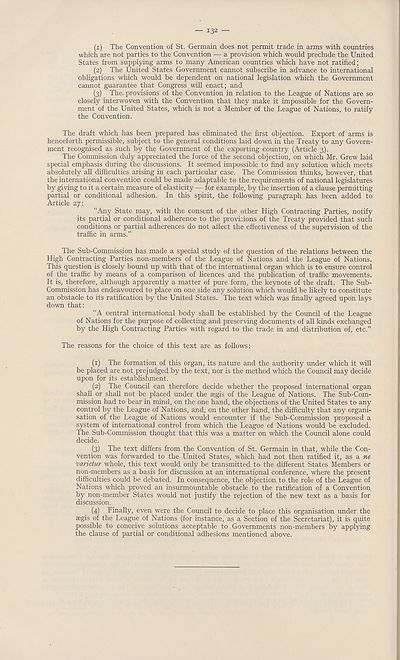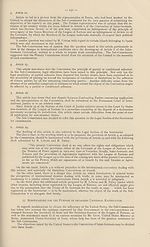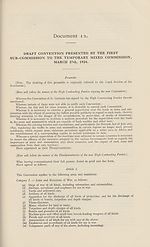Armament > Conference for the control of the international trade in arms, munitions and implements of war
(134)
Download files
Complete book:
Individual page:
Thumbnail gallery: Grid view | List view

— 132 —
(1) The Convention of St. Germain does not permit trade in arms with countries
which are not parties to the Convention — a provision which would preclude the United
States from supplying arms to many American countries which have not ratified;
(2) The United States Government cannot subscribe in advance to international
obligations which would be dependent on national legislation which the Government
cannot guarantee that Congress will enact; and
(3) The. provisions of the Convention in relation to the League of Nations are so
closely interwoven with the Convention that they make it impossible for the Govern¬
ment of the United States, which is not a Member of the League of Nations, to ratify
the Convention.
The draft which has been prepared has eliminated the first objection. Export of arms is
henceforth permissible, subject to the general conditions laid down in the Treaty to any Govern¬
ment recognised as such by the Government of the exporting country (Article 3).
The Commission duly appreciated the force of the second objection, on which Mr. Grew laid
special emphasis during the discussions. It seemed impossible to find any solution which meets
absolutely all difficulties arising in each particular case. The Commission thinks, however, that
the international convention could be made adaptable to the requirements of national legislatures
by giving to it a certain measure of elasticity — for example, by the insertion of a clause permitting
partial or conditional adhesion. In this spirit, the following paragraph has been added to
Article 27:
“Any State may, with the consent of the other High Contracting Parties, notify
its partial or conditional adherence to the provisions of the Treaty provided that such
conditions or partial adherences do not affect the effectiveness of the supervision of the
traffic in arms.”
The Sub-Commission has made a special study of the question of the relations between the
High Contracting Parties non-members of the League of Nations and the League of Nations.
This question is closely bound up with that of the international organ which is to ensure control
of the traffic by means of a comparison of licences and the publication of traffic movements.
It is, therefore, although apparently a matter of pure form, the keynote of the draft. The Sub-
Commission has endeavoured to place on one side any solution which would be likely to constitute
an obstacle to its ratification by the United States. The text which was finally agreed upon lays
down that:
"A central international body shall be established by the Council of the League
of Nations for the purpose of collecting and preserving documents of all kinds exchanged
by the High Contracting Parties with regard to the trade in and distribution of, etc.”
The reasons for the choice of this text are as follows:
(1) The formation of this organ, its nature and the authority under which it will
be placed are not prejudged by the text, nor is the method which the Council may decide
upon for its establishment.
(2) The Council can therefore decide whether the proposed international organ
shall or shall not be placed under the aegis of the League of Nations. The Sub-Com¬
mission had to bear in mind, on the one hand, the objections of the United States to any
control by the League of Nations, and, on the other hand, the difficulty that any organi¬
sation of the League of Nations would encounter if the Sub-Commission proposed a
system of international control from which the League of Nations would be excluded.
The Sub-Commission thought that this was a matter on which the Council alone could
decide.
(3) The text differs from the Convention of St. Germain in that, while the Con¬
vention was forwarded to the United States, which had not then ratified it, as a ne
varietur whole, this text would only be transmitted to the different States Members or
non-members as a basis for discussion at an international conference, where the present
difficulties could be debated. In consequence, the objection to the role of the League of
Nations which proved an insurmountable obstacle to the ratification of a Convention
by non-member States would not justify the rejection of the new text as a basis for
discussion.
(4) Finally, even were the Council to decide to place this organisation under the
aegis of the League of Nations (for instance, as a Section of the Secretariat), it is quite
possible to conceive solutions acceptable to Governments non-members by applying
the clause of partial or conditional adhesions mentioned above.
(1) The Convention of St. Germain does not permit trade in arms with countries
which are not parties to the Convention — a provision which would preclude the United
States from supplying arms to many American countries which have not ratified;
(2) The United States Government cannot subscribe in advance to international
obligations which would be dependent on national legislation which the Government
cannot guarantee that Congress will enact; and
(3) The. provisions of the Convention in relation to the League of Nations are so
closely interwoven with the Convention that they make it impossible for the Govern¬
ment of the United States, which is not a Member of the League of Nations, to ratify
the Convention.
The draft which has been prepared has eliminated the first objection. Export of arms is
henceforth permissible, subject to the general conditions laid down in the Treaty to any Govern¬
ment recognised as such by the Government of the exporting country (Article 3).
The Commission duly appreciated the force of the second objection, on which Mr. Grew laid
special emphasis during the discussions. It seemed impossible to find any solution which meets
absolutely all difficulties arising in each particular case. The Commission thinks, however, that
the international convention could be made adaptable to the requirements of national legislatures
by giving to it a certain measure of elasticity — for example, by the insertion of a clause permitting
partial or conditional adhesion. In this spirit, the following paragraph has been added to
Article 27:
“Any State may, with the consent of the other High Contracting Parties, notify
its partial or conditional adherence to the provisions of the Treaty provided that such
conditions or partial adherences do not affect the effectiveness of the supervision of the
traffic in arms.”
The Sub-Commission has made a special study of the question of the relations between the
High Contracting Parties non-members of the League of Nations and the League of Nations.
This question is closely bound up with that of the international organ which is to ensure control
of the traffic by means of a comparison of licences and the publication of traffic movements.
It is, therefore, although apparently a matter of pure form, the keynote of the draft. The Sub-
Commission has endeavoured to place on one side any solution which would be likely to constitute
an obstacle to its ratification by the United States. The text which was finally agreed upon lays
down that:
"A central international body shall be established by the Council of the League
of Nations for the purpose of collecting and preserving documents of all kinds exchanged
by the High Contracting Parties with regard to the trade in and distribution of, etc.”
The reasons for the choice of this text are as follows:
(1) The formation of this organ, its nature and the authority under which it will
be placed are not prejudged by the text, nor is the method which the Council may decide
upon for its establishment.
(2) The Council can therefore decide whether the proposed international organ
shall or shall not be placed under the aegis of the League of Nations. The Sub-Com¬
mission had to bear in mind, on the one hand, the objections of the United States to any
control by the League of Nations, and, on the other hand, the difficulty that any organi¬
sation of the League of Nations would encounter if the Sub-Commission proposed a
system of international control from which the League of Nations would be excluded.
The Sub-Commission thought that this was a matter on which the Council alone could
decide.
(3) The text differs from the Convention of St. Germain in that, while the Con¬
vention was forwarded to the United States, which had not then ratified it, as a ne
varietur whole, this text would only be transmitted to the different States Members or
non-members as a basis for discussion at an international conference, where the present
difficulties could be debated. In consequence, the objection to the role of the League of
Nations which proved an insurmountable obstacle to the ratification of a Convention
by non-member States would not justify the rejection of the new text as a basis for
discussion.
(4) Finally, even were the Council to decide to place this organisation under the
aegis of the League of Nations (for instance, as a Section of the Secretariat), it is quite
possible to conceive solutions acceptable to Governments non-members by applying
the clause of partial or conditional adhesions mentioned above.
Set display mode to:
![]() Universal Viewer |
Universal Viewer | ![]() Mirador |
Large image | Transcription
Mirador |
Large image | Transcription
Images and transcriptions on this page, including medium image downloads, may be used under the Creative Commons Attribution 4.0 International Licence unless otherwise stated. ![]()
| League of Nations > Armament > Conference for the control of the international trade in arms, munitions and implements of war > (134) |
|---|
| Permanent URL | https://digital.nls.uk/195383505 |
|---|
| Shelfmark | LN.IX |
|---|
| Description | Over 1,200 documents from the non-political organs of the League of Nations that dealt with health, disarmament, economic and financial matters for the duration of the League (1919-1945). Also online are statistical bulletins, essential facts, and an overview of the League by the first Secretary General, Sir Eric Drummond. These items are part of the Official Publications collection at the National Library of Scotland. |
|---|---|
| Additional NLS resources: |
|

